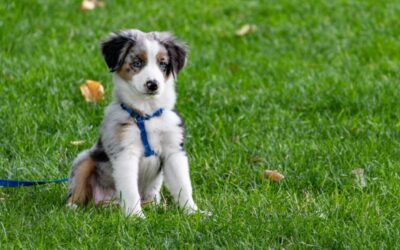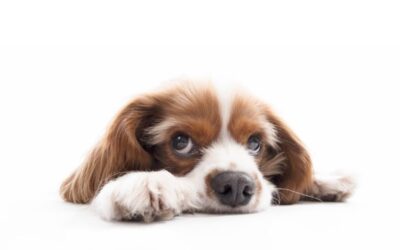Yes, a dog’s hair will usually grow back after a scab. When a dog experiences a scab, it is often due to a minor skin injury or irritation, such as a scratch or a bug bite.
The scab acts as a protective barrier while the skin underneath heals. As the healing process progresses, new hair will typically begin to grow in the affected area, gradually replacing the scab. This is a natural part of the body’s healing process.
However, if the scab is a result of a more serious condition or if the hair loss persists, it is best to consult a veterinarian for proper diagnosis and treatment.
Causes And Symptoms Of Scabs In Dogs
Scabs in dogs can be caused by various factors, such as allergies, infections, or injuries. Common symptoms include itching, redness, and hair loss around the scabbed area. With proper care and treatment, a dog’s hair has the potential to grow back after the scab falls off.
Scabs on
Allergies And Skin Irritations:
- Allergies: Dogs can develop allergies to various environmental factors, including pollen, dust mites, or certain foods. Allergic reactions can cause itching, redness, and the formation of scabs.
- Irritants: Contact with certain substances such as chemicals, harsh shampoos, or even certain fabrics can irritate a dog’s skin, leading to scabs.
- Hot spots: When dogs excessively scratch, lick, or chew a specific area, it creates a moist, warm environment that encourages the growth of bacteria, resulting in scabs.
Parasites And Fleas:
- Fleas: Flea bites can cause intense itching and irritation, leading to scabs on a dog’s skin. It is essential to check and treat dogs for fleas regularly.
- Mites: Various types of mites, such as mange mites, can infest a dog’s skin, causing severe itching, hair loss, and scabs. These mites need proper veterinary treatment to eliminate the infestation.
Infections And Underlying Health Conditions:
- Bacterial infections: Scratching and biting at the skin can cause open wounds, making dogs susceptible to bacterial infections. These infections can result in scab formation.
- Fungal infections: Fungi like Ringworm can cause itchy, red patches on a dog’s skin, leading to scabs. Prompt treatment is necessary to prevent the infection from spreading and causing further scabbing.
- Underlying health conditions: Certain medical conditions, such as autoimmune disorders or hormonal imbalances, can weaken a dog’s immune system, making them more prone to scabs and skin issues.
Identifying the potential cause of scabs in your dog can help determine the best course of action for treatment. Consulting with a veterinarian is crucial to ensure proper diagnosis and effective treatment options. Remember, providing regular grooming, a balanced diet, and a safe environment can help prevent scabs and promote optimal skin health for your canine companion.
Treating Scabs In Dogs
Dog owners often wonder if their pet’s hair will grow back after a scab. Thankfully, with proper treatment, the dog’s hair usually does grow back, allowing them to look healthy and happy once again.
Scabs on dogs can be a common occurrence, often caused by minor injuries or skin conditions. However, it’s important to address scabs promptly to prevent infections and ensure your furry friend’s comfort. Here are some effective ways to treat scabs in dogs:
Proper Hygiene And Grooming Practices:
- Regularly bathe your dog using a gentle, hypoallergenic shampoo to keep their skin clean and free from dirt, debris, and potential irritants.
- Use a soft brush or comb to remove any loose fur or debris from the affected area. Be gentle to avoid causing further irritation or damage to the scabs.
- Trim your dog’s nails regularly to prevent them from scratching and further aggravating the scabs.
- Ensure that your dog’s living environment is clean and free from fleas, ticks, and other pests that can worsen skin conditions.
Use Of Medicated Shampoos And Sprays:
- Consult your veterinarian for recommendations on medicated shampoos and sprays specifically formulated to treat scabs in dogs. These products can help soothe the affected area, reduce itching, and promote healing.
- Follow the instructions provided by your veterinarian or the product label when using medicated shampoos and sprays. Be sure to apply them to the affected area and rinse thoroughly.
Topical Treatments For Scab Relief:
- Your veterinarian may prescribe topical ointments or creams containing ingredients like antibiotics, anti-inflammatory agents, or antifungals to treat scabs effectively.
- Apply the prescribed topical treatments as directed, ensuring that you cover the affected area completely. Gently massage the product into the skin for better absorption.
- Avoid using any over-the-counter topical treatments without consulting your veterinarian, as some products may be ineffective or even harmful to your dog’s skin.
By following proper hygiene and grooming practices, using medicated shampoos and sprays, and utilizing appropriate topical treatments, you can help alleviate your dog’s scabs and promote the regrowth of healthy hair. If the scabs persist or worsen despite your efforts, it’s essential to seek veterinary attention for further evaluation and treatment.
Remember, your dog’s well-being is worth the extra care and attention to ensure a healthy, scab-free coat.
Promoting Hair Growth In Dogs
Dog owners often wonder if their canine companions’ hair will regrow after scabs fall off. Understanding the factors that influence hair growth in dogs can help promote healthy and optimal regrowth of their fur.
A healthy coat is not only visually appealing but also indicates the overall well-being of your furry friend. If your dog has experienced scabs or hair loss, you may be wondering if their hair will grow back. Fortunately, there are several ways to promote hair growth in dogs.
Here are some tips and remedies to consider:
Healthy Diet And Supplements For Skin And Coat Health:
- Ensure your dog’s diet is well-balanced and includes high-quality proteins, fatty acids, vitamins, and minerals.
- Omega-3 fatty acids can help reduce inflammation and promote a healthy coat. Consider adding fish oil or flaxseed oil to their diet.
- Supplements like biotin and zinc can support skin health and hair growth. Consult your veterinarian before introducing any new supplements.
Regular Exercise And Stimulation For Overall Well-Being:
- Regular physical activity helps improve blood circulation, which can benefit hair follicles and promote hair growth.
- Engage your dog in activities that stimulate their mind and body. Puzzle toys, interactive games, and training sessions can help keep them active and happy.
Remedies And Therapies To Stimulate Hair Growth:
- Gentle brushing can improve blood circulation to the skin and remove dead hair, promoting new hair growth.
- Consider using specialized shampoos or conditioners formulated for promoting hair growth or soothing the skin.
- Therapies such as laser therapy or acupuncture may help stimulate hair follicles and promote regrowth. Consult with a professional for suitable options.
Remember, each dog is unique, and the time it takes for their hair to grow back may vary. Patience and consistency with these tips can help promote a healthy coat and encourage hair growth. If you have concerns about your dog’s hair loss or scabs, it’s always best to consult with a veterinarian for a proper diagnosis and tailored advice.
With the right care and attention, your dog’s coat will have the opportunity to flourish once again, giving them the confidence and comfort they deserve.
Managing Scabs During The Healing Process
Dog owners often wonder if their pet’s hair will grow back after a scab form during the healing process. The answer is generally yes, but it depends on the severity of the wound and the dog’s individual healing ability.
Scabs are a natural part of the healing process when it comes to dog skin injuries. While they might appear unsightly and cause discomfort to your furry friend, they usually indicate that the wound is starting to heal. However, it’s important to manage these scabs properly to ensure that your dog’s hair grows back smoothly.
In this section, we will discuss some effective ways to manage scabs during the healing process.
Prevention Of Further Scratching And Irritation:
- Keep your dog’s nails trimmed short to reduce the risk of scratching and aggravating the scabs.
- Use an Elizabethan collar, commonly known as a cone, to prevent your dog from licking or biting the scabs.
- Create a calm and comfortable environment for your dog to minimize stress and lessen the chance of excessive scratching.
- Maintain a regular grooming routine to keep your dog’s coat clean and free from any irritants that might worsen the scabs.
Application Of Protective Barriers And Bandages:
- Apply a thin layer of pet-safe ointment or antibiotic cream to the scabs to keep them moisturized and promote healing.
- Cover the scabs with sterile gauze pads or bandages to protect them from further trauma and prevent your dog from scratching them.
- Ensure that the bandages are not too tight, as they should allow proper airflow to the affected area.
- Change the bandages regularly to keep them clean and prevent any infection.
Monitoring And Addressing Any Complications:
- Keep a close eye on the healing process and check for any signs of infection, such as excessive redness, swelling, or discharge.
- If you notice any complications, consult your veterinarian immediately for appropriate treatment.
- Follow your veterinarian’s instructions for any prescribed medications or treatments to help the scabs heal without any complications.
- Provide proper nutrition and a balanced diet to support your dog’s overall health, which can contribute to the healing process.
Remember, managing scabs during the healing process requires patience and consistency. With proper care and treatment, your dog’s hair will have a higher chance of growing back smoothly. By following these guidelines, you can help your furry friend recover comfortably and ensure their skin heals properly.
Consulting A Veterinarian
Consulting a veterinarian is essential when dealing with a dog’s scab and hair growth concerns. They can provide expert guidance on whether the hair will grow back and offer appropriate treatments and care for your furry companion.
If you notice that your dog has scabs and you’re worried about their hair growing back, it’s essential to consult a veterinarian. They are the experts who can provide a proper diagnosis and recommend appropriate treatments. Here’s what you need to know about consulting a veterinarian for scab-related concerns:
When To Seek Professional Help
Determining when your dog’s scab issue requires professional help can be challenging. However, there are some signs that indicate it’s time to consult a veterinarian. Consider seeking professional assistance if:
- The scabs are widespread or increasing in number.
- The scabs are accompanied by other symptoms such as itching, hair loss, or skin inflammation.
- The scabs don’t improve or worsen over time.
- The scabs are causing discomfort or pain to your dog.
Diagnostic Tests And Examinations
When you visit a veterinarian regarding your dog’s scabs, they will likely perform several diagnostic tests and examinations to assess the underlying cause. These can include:
- Skin scrapings or swabs: To check for bacterial or fungal infections.
- Blood tests evaluate your dog’s overall health and rule out systemic issues.
- Allergy testing: To determine if the scabs are a result of allergies or sensitivities.
- Skin biopsies: In severe cases where the underlying cause is not evident.
Medications And Treatments Prescribed By Veterinarians
Once the veterinarian has identified the cause of the scabs, they will recommend appropriate medications and treatments. These may include:
- Topical creams or ointments: To address bacterial or fungal infections.
- Oral medications: Such as antibiotics or antifungals for systemic infections.
- Medicated shampoos: To soothe the skin and promote healing.
- Allergy management: Through dietary changes or immunotherapy.
- Parasite control: To address issues caused by fleas, ticks, or mites.
Remember, always follow the veterinarian’s advice and complete the prescribed treatment course for the best chance of your dog’s hair growing back after scabs. Their expertise and guidance are crucial for your furry friend’s well-being.
Consulting a veterinarian is essential when dealing with your dog’s scabs, as they can provide a proper diagnosis, recommend diagnostic tests and examinations, and prescribe the necessary medications and treatments for their recovery. By seeking professional help, you ensure your dog receives the best care possible for their scab-related concerns.
Preventing Scabs In Dogs
Scabs in dogs can lead to hair loss, but in most cases, the hair will grow back once the scabs heal. Providing proper care, such as keeping the area clean and giving your dog a healthy diet, can help promote the regrowth of their fur.
Dogs can be prone to developing scabs on their skin, causing discomfort and curiosity about whether their hair will grow back. Preventing scabs in dogs is crucial to maintaining their overall well-being. By following some simple guidelines, you can help keep your furry friend scab-free and ensure their hair grows back smoothly.
Regular Flea Prevention And Parasite Control:
- Use veterinarian-recommended flea prevention products regularly.
- Apply flea treatments according to the instructions to prevent infestations.
- Use flea combs and regular grooming to check for any signs of fleas or parasites.
- Consult your vet for the best flea control options for your dog’s specific needs.
Maintaining A Clean And Safe Living Environment:
- Clean your dog’s living area regularly to prevent the accumulation of dirt, debris, and potential irritants.
- Regularly wash your dog’s bedding and toys to minimize the risk of skin irritations.
- Avoid using harsh chemicals or cleaners that could cause skin sensitivity.
- Keep your dog away from areas where they could come into contact with allergens or potential irritants.
Regular Check-Ups With The Veterinarian For Early Detection:
- Schedule regular check-ups with your vet to monitor your dog’s skin health.
- Early detection of any underlying health conditions can prevent scabs from forming.
- Your vet can provide recommendations for any necessary tests or treatments to address any potential issues.
- Regular vaccinations and preventive measures can also help maintain your dog’s overall health and prevent scabs.
By following these preventive measures, you can reduce the chances of scabs appearing on your dog’s skin and promote healthy hair regrowth. Remember, maintaining a clean environment, regular check-ups, and proper parasite control are key to preventing scabs and ensuring your furry friend’s comfort and well-being.
Frequently Asked Questions For Will Dog’S Hair Grow Back After Scab
Will Hair Grow Back After the Scab?
Yes, hair will typically regrow after a scab has healed on the scalp.
What Helps Dog Fur Grow Back?
Proper nutrition, grooming, and regular vet check-ups help dog fur grow back healthy and strong.
Does Fur Grow Over Scars?
Yes, fur can grow over scars. Fur growth can partially or completely cover scars.
Does Dog Skin Grow Back?
Yes, dog skin can regenerate and grow back when it gets injured or damaged.
Conclusion
Dog owners can be hopeful that their pet’s hair will grow back after a scab. With proper care, including a balanced diet, regular grooming, and preventing further irritation, the healing process can be expedited. While the timeline for hair regrowth varies depending on the severity of the scab and the individual dog, patience is key.
It is important to remember that each dog is unique and may require different treatments to promote hair growth. Consulting with a veterinarian is always recommended to ensure the best course of action for your furry friend. So, don’t worry if your dog has a scab.
With time and the right care, their hair will likely grow back, allowing them to look and feel their best once again.




